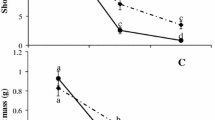Abstract
The irrigation district of the lower valley of Río Colorado (62° 37′ W, 39° 23′ S) was examined during 1995 and 1996 to evaluate propagule bank abundance and regeneration in five irrigation and five drainage channel sites. Six 15 cm deep cores from each site were collected in late winter and sectioned into two subsamples. One was sieved to identify taxa and propagule density and the other was placed under controlled laboratory conditions to record emergence over 90 days. Mean propagule density of Potamogeton pectinatus (260 tubers. m-2, 173 rhizome nodes. m-2 and 246 seeds. m-2) and Zannichellia palustris (968 seeds. m-2) was higher in irrigation than in drainage channels. By contrast, higher values in drainage channels were recorded for Ruppia maritima (4352 seeds. m-2) and Chara contraria (35633 oospores. m-2). Plant emergence in P. pectinatus was independent of channel type. Higher and lower values were registered in irrigation channels for Z. palustris and the other two species, respectively. Plant emergence in relation to propagule density for all the species ranged from 24% to 56%, and no differences were found between irrigation and drainage channels. Results are discussed in relation to the established vegetation and the different management and environmental conditions of both types of channels.
Similar content being viewed by others
References
Barrat-Segretain, M.H., 1996. Strategies of reproduction, dispersion, and competition in river plants: a review. Vegetatio 123: 13–37.
Bonis, A., J. Lepart & P. Grillas, 1995. Seed bank dynamic and coexistence of annual macrophytes in a temporary and variable habitat. Oikos 74: 81–92.
Cáceres, E. J., 1978. Contribución al conocimiento de carófitos del centro de Argentina Acad. Nac. Cienc. 2: 316–372.
Costa, C. S. B. & V. Seeliger, 1989. Vertical distribution and resource allocation of Ruppia maritima L. in a southern Brazilian estuary. Aquat. Bot. 33: 123–129.
Fernández, O. A., J.H. Irigoyen, M.R. Sabbatini & R.E. Brevedan, 1987. Aquatic plant mgmt in drainage channels of southern Argentina. J. Aquat. Plant Manage. 25: 65–67.
Fernández, O. A., K. J. Murphy, A. López Cazorla, M. R. Sabbatini, M. A. Lazzari, J. C. J. Domaniewski & J. H. Irigoyen, 1998. Interrelationships of fish and channel environmental conditions with aquatic macrophytes in an Argentine irrigation system. Hydrobiologia 380: 18–25.
Kantrud, H. A., 1990. Sago pondweed (Potamogeton pectinatus L.): a literature review. United States Department of the Interior, Fish & Wildlife Service. Resource publication 176: 91 pp.
Kantrud, H. A., 1991. Wigeongrass (Ruppia maritima L.): a literature review. United States Department of the Interior, Fish & Wildlife Serv. Res. 10: 58 pp.
Kaustky, L., 1987. Life cycles of three populations of Potamogeton pectinatus L. at different degrees of wave exposure in Askö area, northern Baltic proper. Aquat. Bot. 27: 177–186.
Kaustky, L., 1990. Seed and tuber banks of aquatic macrophytes in Askö area, northern Baltic proper. Holarct. Ecol. 13: 143–148.
Murphy, K. J., R. G. Hanbury & J. Eaton, 1981. The ecological effects 2-methylthio triazine herbicides used for aquatic weed control in navigable canals: 1. Effects on aquatic flora and water chemistry. Arch. Hydrobiol. 91: 231–294.
Sabbatini, M. R., J. H. Irigoyen & O. A. Fernández, 1986. Phenology and biomass dynamic of Chara contraria A. Braun ex Kütz. in drainage channels of a temperate irrigation area in Argentina. 7th International Symposium on Aquatic Weeds. Loughborough, Leicestershire, England. 15–19 September 1986: 285–289.
Sabbatini, M. R., K. J. Murphy & J. H. Irigoyen, 1998. Vegetationenvironment relationships in irrigation channel systems of southern Argentina. Aquat. Bot. 60: 119–133.
Scott, D. W., R. J. M. Dwayne & A. K. Paul, 1993. Relationships of marsh seed banks to vegetation patterns along environmental gradients. Freshwat. Biol. 29: 361–370.
Van Vierssen, W., 1982. The ecology of communities dominated by Zannichellia taxa in western Europe I. Characterisation and autoecology of the Zannichellia taxa. Aquat. Bot. 12: 103–155.
VanWijk, R. J., 1988. Ecological studies on Potamogeton pectinatus L. I. General characteristics. biomass production and life cycles under field conditions. Aquat. Bot. 31: 211–258.
Wade, P.M., 1990. The colonisation of disturbed freshwater habitats by Characeae. Folia Geobot. Phytotax., Praha 25: 275–278.
Welling, C. H., R. L. Pederson & A. G. Van der Valk, 1988. Recruitment from the seed bank and the development of zonation of emergent vegetation during a drawdown in a prairie wetland. J. Ecol. 76: 483–496.
Westcott, K., T. H. Whillans & M. G. Fox, 1997. Viability and abundance of seeds of submerged macrophytes in the sediment of disturbed and reference shoreline marshes in Lake Ontario. Can. J. Bot. 75: 451–456.
Wiegleb, G., H. Brux & W. Herr, 1991.Human impact on the ecological performance of Potamogeton species in north-western Germany. Vegetatio 97: 161–172.
Author information
Authors and Affiliations
Rights and permissions
About this article
Cite this article
Acosta, L.W., Sabbatini, M.R., Fernández, O.A. et al. Propagule bank and plant emergence of macrophytes in artificial channels of a temperate irrigation area in Argentina . Hydrobiologia 415, 1–5 (1999). https://doi.org/10.1023/A:1003808713907
Issue Date:
DOI: https://doi.org/10.1023/A:1003808713907




